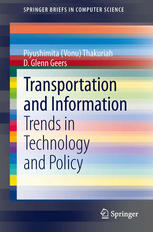

Most ebook files are in PDF format, so you can easily read them using various software such as Foxit Reader or directly on the Google Chrome browser.
Some ebook files are released by publishers in other formats such as .awz, .mobi, .epub, .fb2, etc. You may need to install specific software to read these formats on mobile/PC, such as Calibre.
Please read the tutorial at this link: https://ebookbell.com/faq
We offer FREE conversion to the popular formats you request; however, this may take some time. Therefore, right after payment, please email us, and we will try to provide the service as quickly as possible.
For some exceptional file formats or broken links (if any), please refrain from opening any disputes. Instead, email us first, and we will try to assist within a maximum of 6 hours.
EbookBell Team

4.8
74 reviewsTransformations in wireless connectivity and location-aware technologies hold the promise of bringing a sea-change in the way transportation information is generated and used in the future. Sensors in the transportation system, when integrated with those in other sectors (for example, energy, utility and health) have the potential to foster novel new ways of improving livability and sustainability.
The end-result of these developments has been somewhat contradictory. Although automation in the transportation environment has become increasingly widespread, the level of involvement and active participation by people, in terms of co-creation and contribution of information, has also increased. As a result, the following two major trends have been observed: (1) increases in Machine-to- Machine (M2M) communications; and (2) increases in the variety and volume of User-Generated Content.
In this transportation paradigm, the pervasive use of Information and Communication Technologies will serve as the foundation for mobility intelligence towards an “ubiquitous information-centered mobility environment”. However, many technical and operational questions, as well as social, management and legal challenges present themselves in the transformation to this vision. The book presents a non-technical review of research and initiatives and a discussion of such opportunities and challenges.